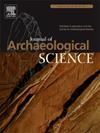Chemical and isotopic analyses confirm dietary change marks the Early Medieval Slavic expansion into Central and Eastern Europe
IF 2.6
1区 地球科学
Q1 ANTHROPOLOGY
引用次数: 0
Abstract
During the first millennium AD, the much-discussed Migration Period marked a major episode of demographic and consequent economic, social and political change across large areas of Europe. Slavic migration from Eastern into Central Europe, between 500 and 700 AD, brings a proposed change in ‘kitchen culture’ and subsistence, displacing Germanic (e.g. Longobard) groups elsewhere, marking the end of the Late Antique period and the beginning of the Middle Ages. Notably, organic residue analysis of a total of 75 vessels from across the span of these periods confirms a distinct dietary shift between these purported groups. Food can often be one of the most distinctive expressions of social, religious, cultural or ethnic groups and, here, we demonstrate that a clear reliance on millet, in the form of porridge made with milk and, possibly, honey or soups and stews with meat, dominates, likely brought from the Slavic homelands. Thus, absent in the late Antique period, a new diet based on millet may thus have been a contributing factor to the population increase during the Early Medieval period and the subsequent expansion by Slavic groups across Europe. Analysis of a large series of legacy radiocarbon dates from human and animal bone, supported by compound-specific lipid dating of four of the same vessels allows us to identify the turning point of the change in habitus, with Slavic-speaking communities with a new housing culture, foodways and burial rites appearing in Moravia (Czech Republic) and Lower Austria, by the latest 598 AD (but probably much earlier, between 560 and 590 AD).
化学和同位素分析证实,饮食的改变标志着中世纪早期斯拉夫人向中欧和东欧的扩张
在公元第一个千年期间,被广泛讨论的移民时期标志着欧洲大片地区人口和随之而来的经济、社会和政治变革的一个重要时期。公元500年至700年间,斯拉夫人从东欧移民到中欧,带来了“厨房文化”和生活方式的改变,取代了其他地方的日耳曼人(如朗戈巴德人)群体,标志着晚期古董时期的结束和中世纪的开始。值得注意的是,对这些时期共75只血管的有机残留物分析证实了这些所谓群体之间明显的饮食变化。食物往往是社会、宗教、文化或种族群体最独特的表达之一,在这里,我们证明了对小米的明显依赖,以牛奶粥的形式,可能是蜂蜜或肉汤和炖菜,占主导地位,可能是从斯拉夫家园带来的。因此,在古代晚期没有,一种以小米为基础的新饮食可能是中世纪早期人口增长和随后斯拉夫群体在欧洲扩张的一个因素。对人类和动物骨骼的大量遗留放射性碳年代分析,以及对四个相同的血管进行化合物特定脂质定年的支持,使我们能够确定居住环境变化的转折点,在最晚的公元598年(但可能更早,在公元560年至590年之间),在摩拉维亚(捷克共和国)和下奥地利出现了新的住房文化,饮食方式和埋葬仪式的斯拉夫语社区。
本文章由计算机程序翻译,如有差异,请以英文原文为准。
求助全文
约1分钟内获得全文
求助全文
来源期刊

Journal of Archaeological Science
地学-地球科学综合
CiteScore
6.10
自引率
7.10%
发文量
112
审稿时长
49 days
期刊介绍:
The Journal of Archaeological Science is aimed at archaeologists and scientists with particular interests in advancing the development and application of scientific techniques and methodologies to all areas of archaeology. This established monthly journal publishes focus articles, original research papers and major review articles, of wide archaeological significance. The journal provides an international forum for archaeologists and scientists from widely different scientific backgrounds who share a common interest in developing and applying scientific methods to inform major debates through improving the quality and reliability of scientific information derived from archaeological research.
 求助内容:
求助内容: 应助结果提醒方式:
应助结果提醒方式:


